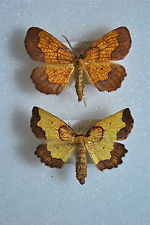The tiny, rare insect is now found only on Strensall Common, an area of protected lowland heath near York, having been lost from Newham Bog in Northumberland. But scientists have found that even in its last stronghold numbers have plunged by over 90% in the last seven years, with only 50-100 thought to remain. The centimetre-wide moths rely on the creeping willow bush to feed their caterpillars but an accidental heath fire destroyed a key area of the bushes in 2009.
Another factor is likely to be increased grazing by sheep. This is intended to preserve the heathland by preventing the growth of trees and tall shrubs but appears to have unwittingly damaged the fortunes of a rare species that the heath management is ultimately designed to protect.
Female dark bordered beauty moths prefer to lay their eggs on large, robust creeping willows in July, so the shortening or loss of the plants by grazing means there are fewer good sites for egg laying and a subsequent decline in moth numbers. The sheep may even be eating the moth eggs as they graze, as the eggs stay on the plant until late spring before they hatch.
“The dark bordered beauty is a very special and charismatic moth, which has been observed and admired at Strensall Common for well over a century,” said Terry Crawford, at York University and one of the research team.
“It has long been part of the natural history heritage of England and of Yorkshire,” he said. “Because of the loss of populations elsewhere in England, the loss of the population at Strensall Common would mean extinction of the moth in England as a whole.” The moth is known at three sites in Scotland.
Source: The Guardian, 23 June, 2016
https://www.theguardian.com/environment/2016/jun/23/rare-dark-bordered-…

- Login om te reageren
